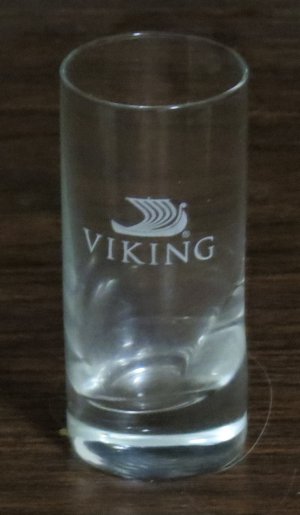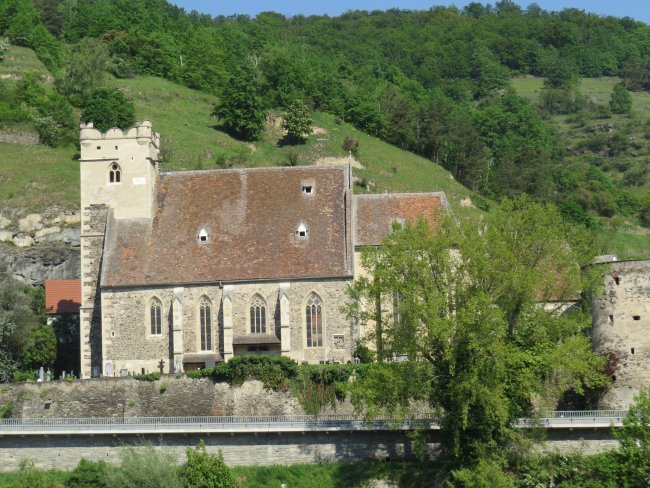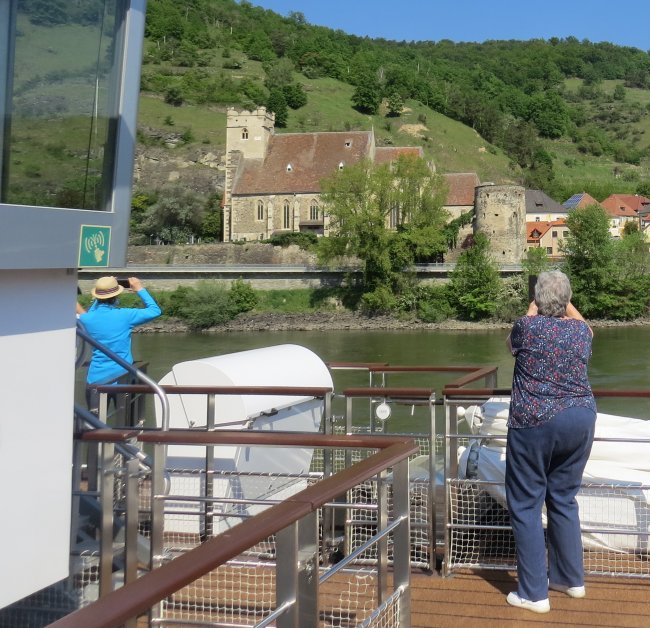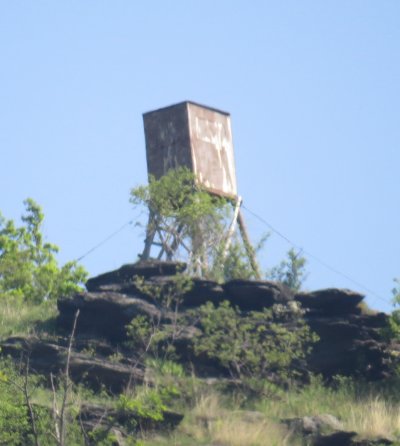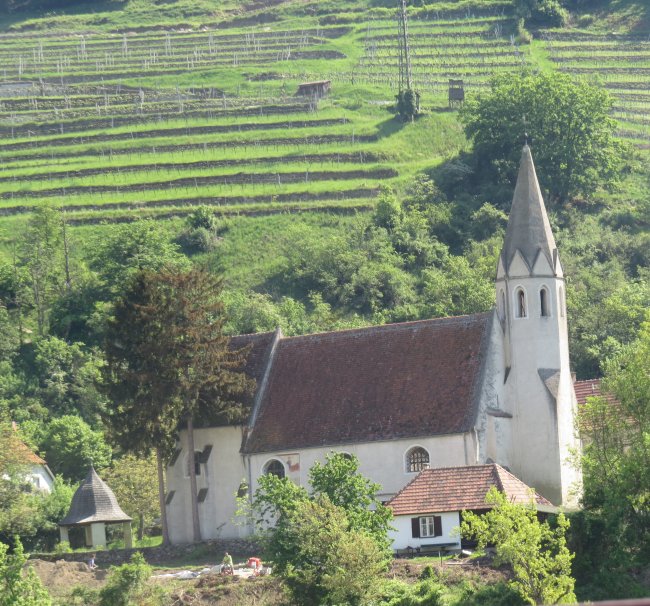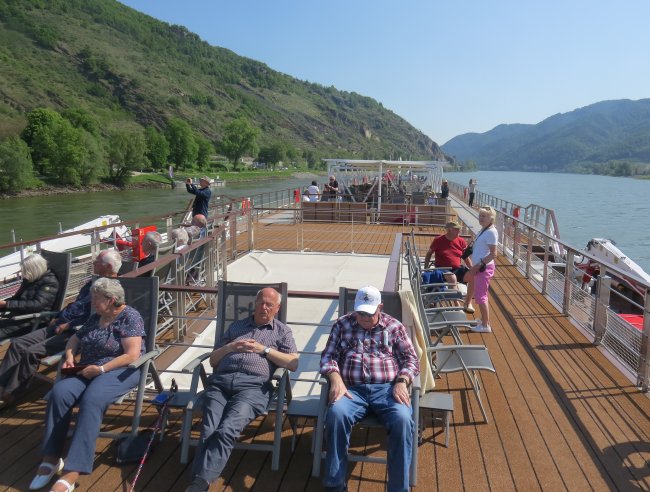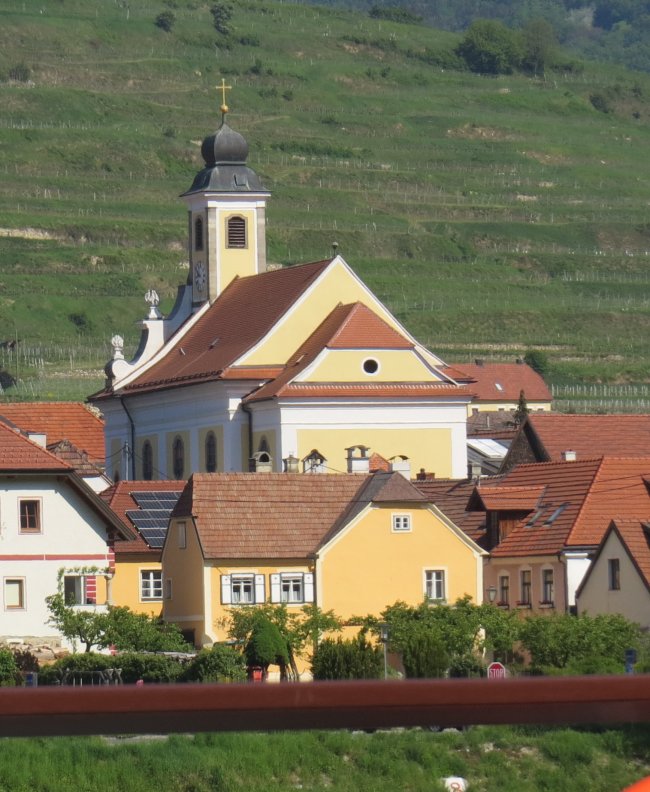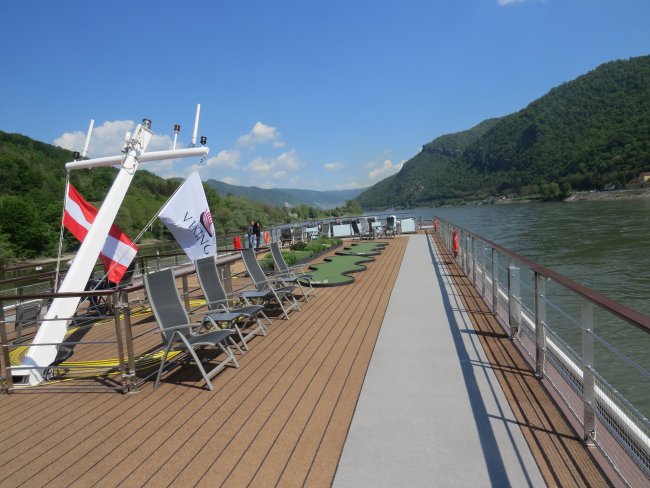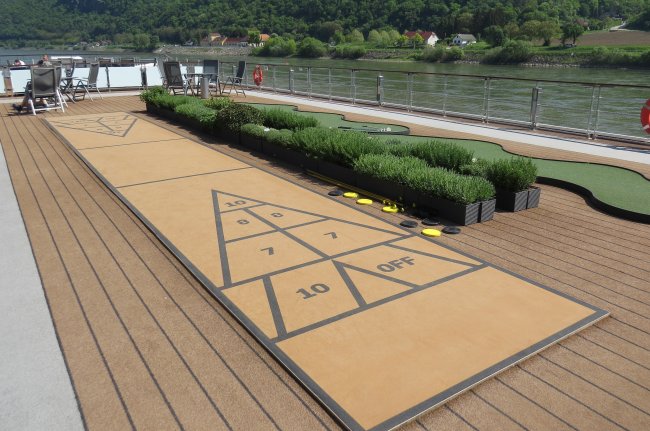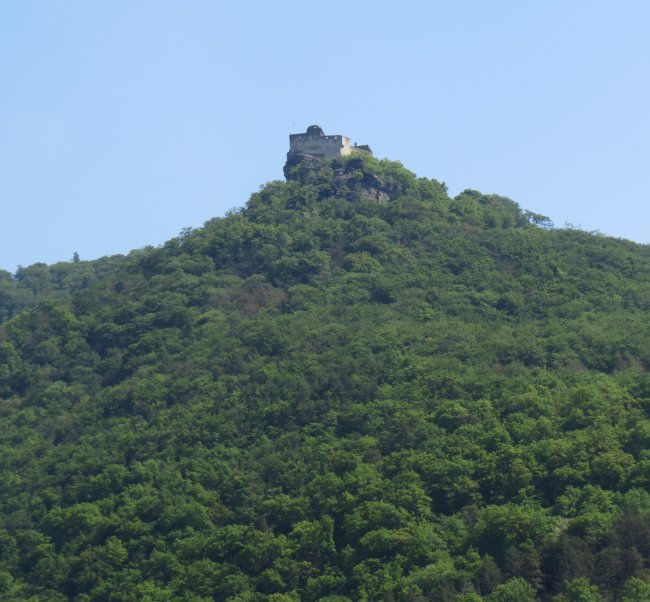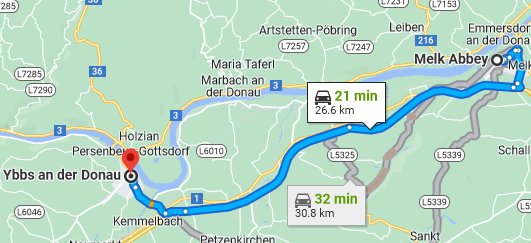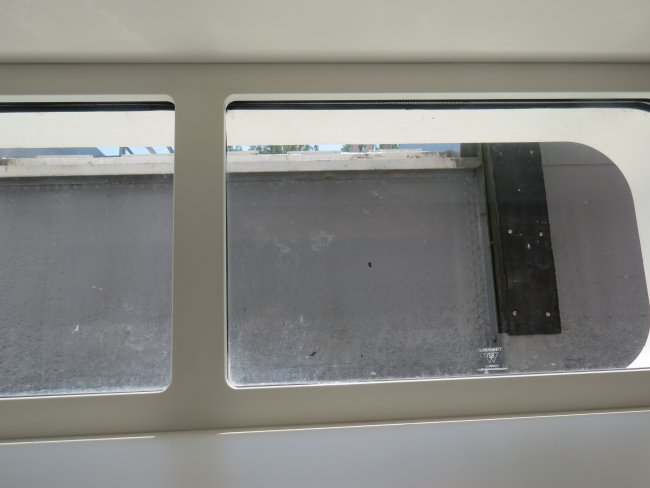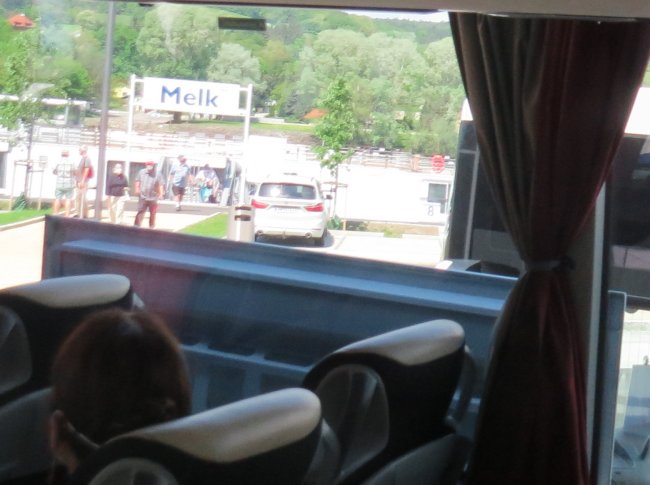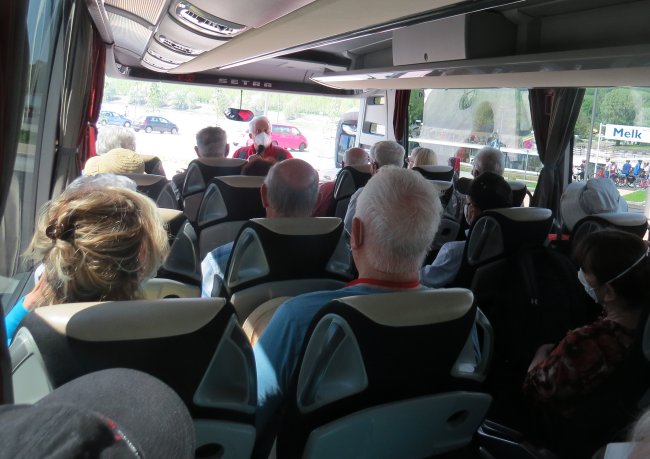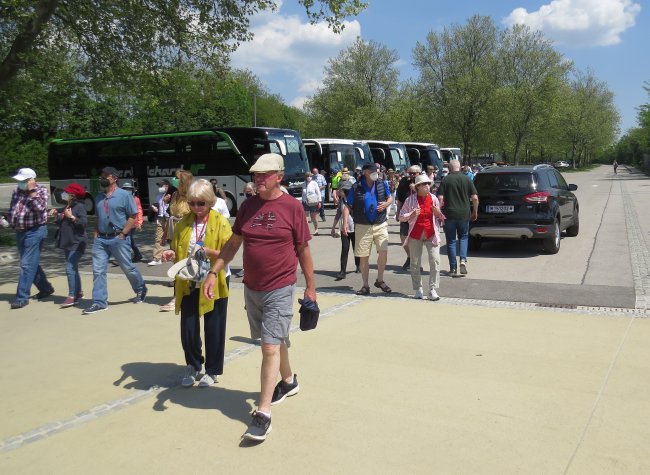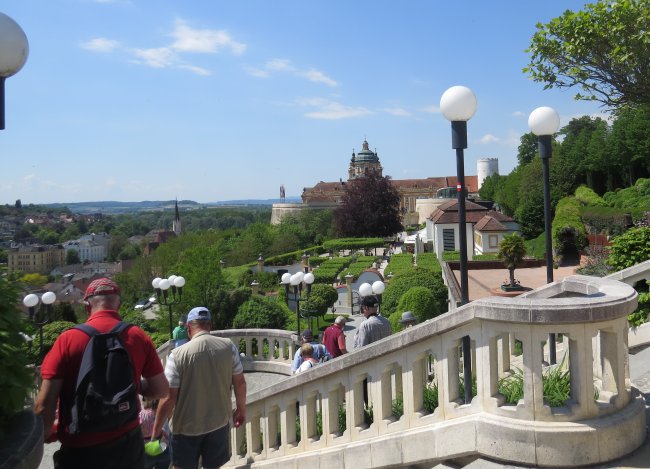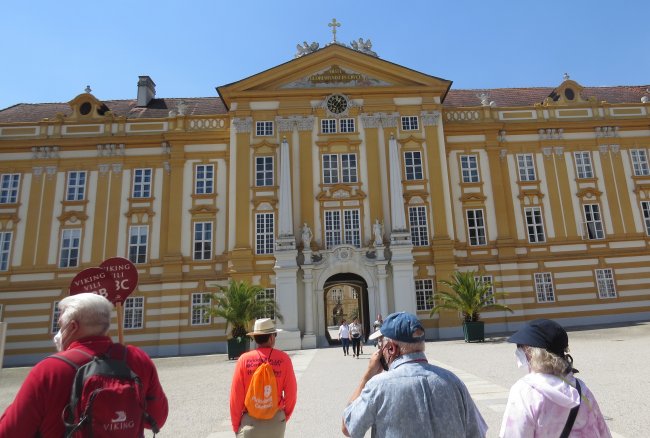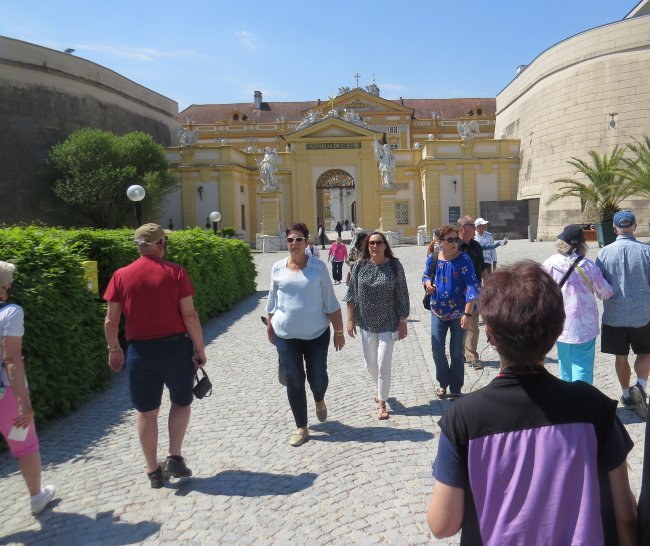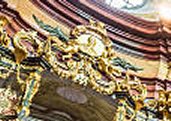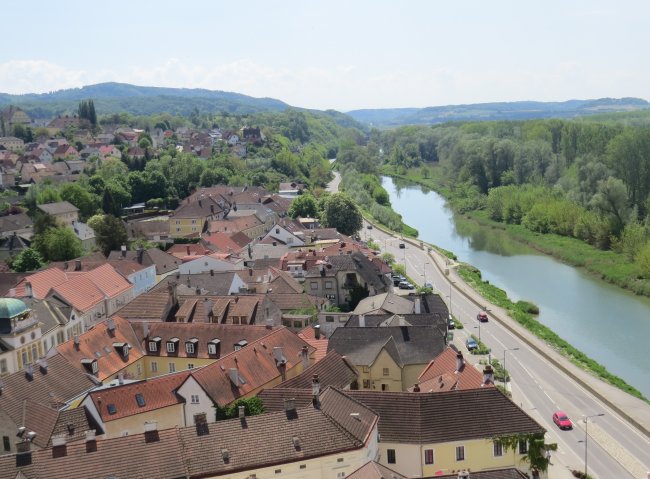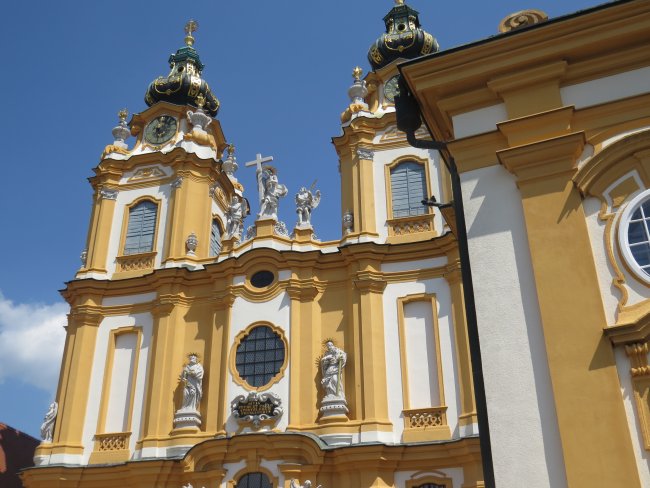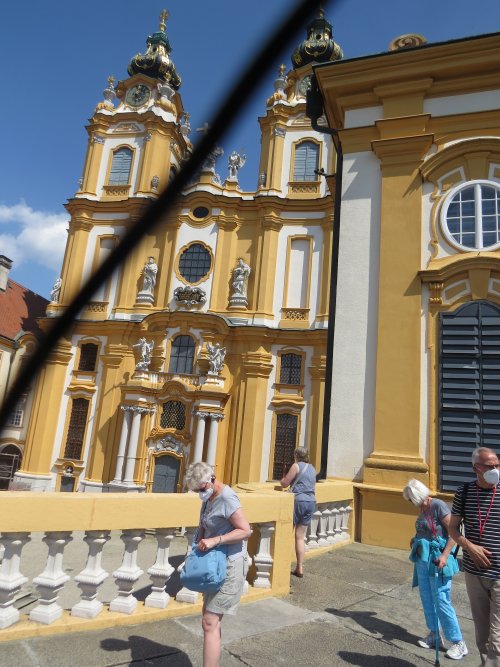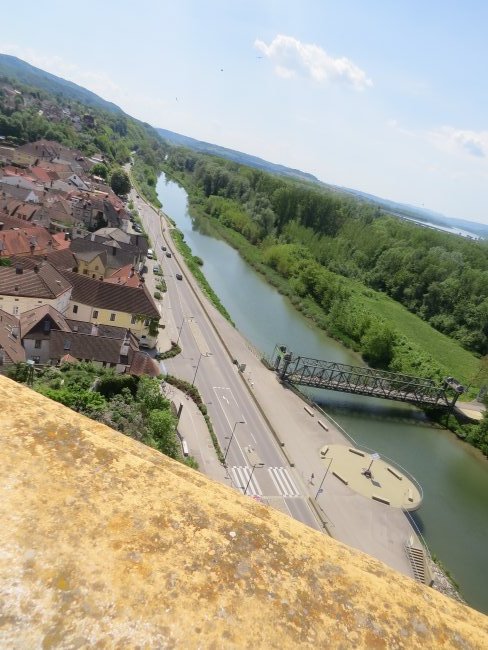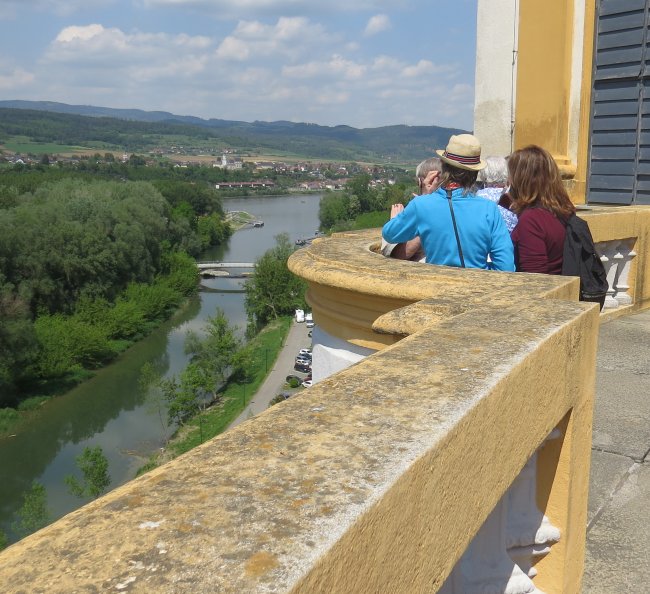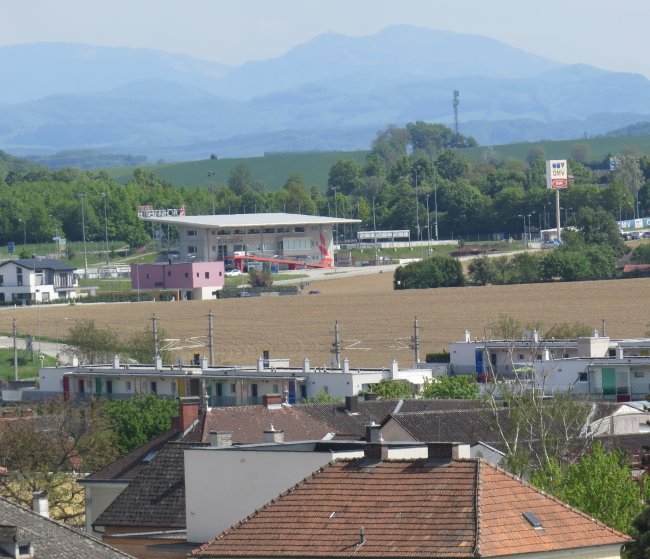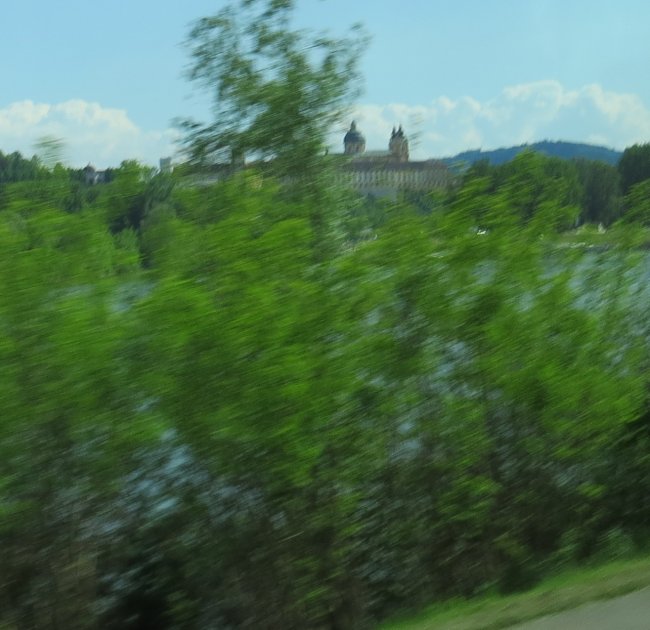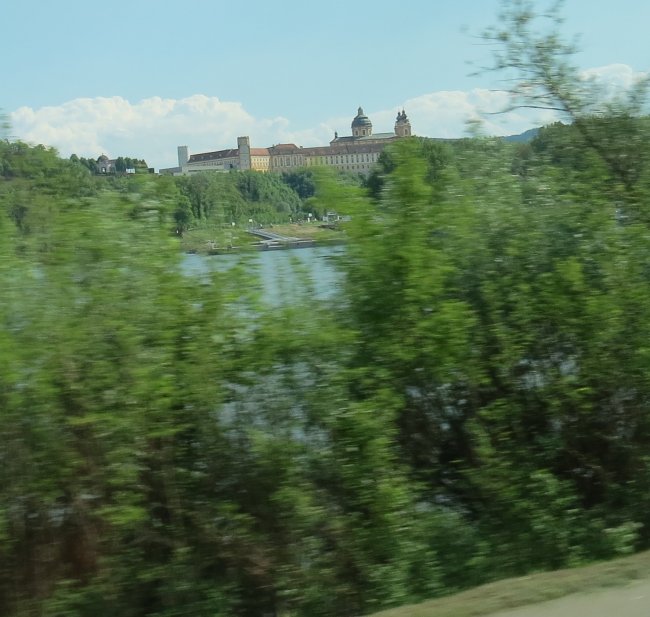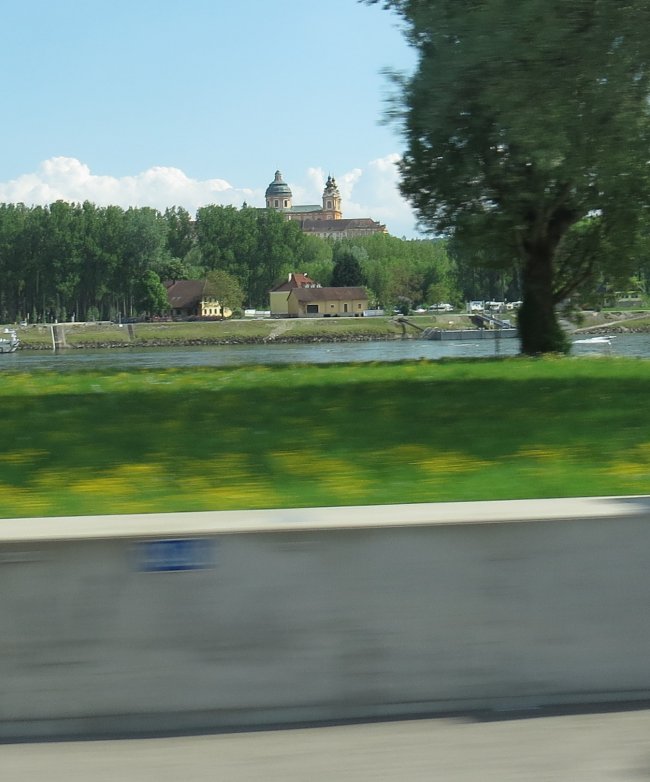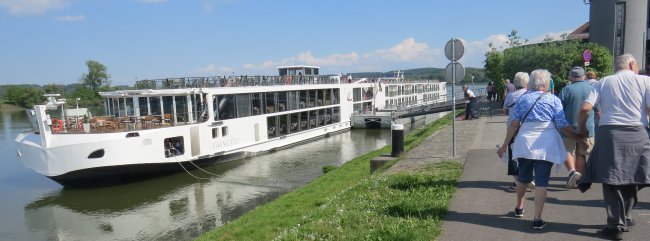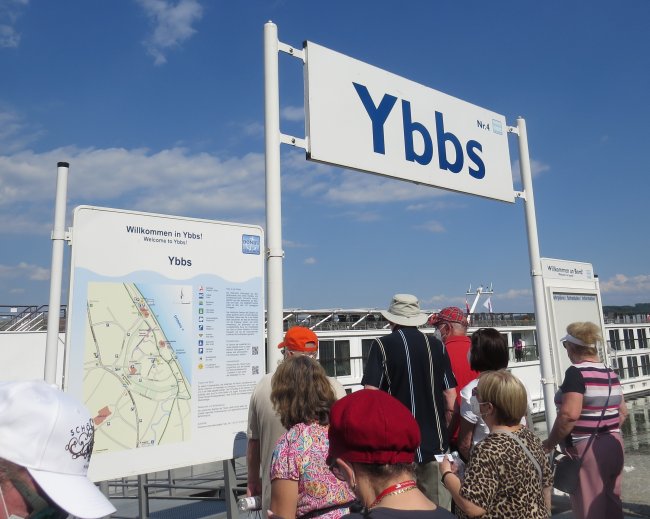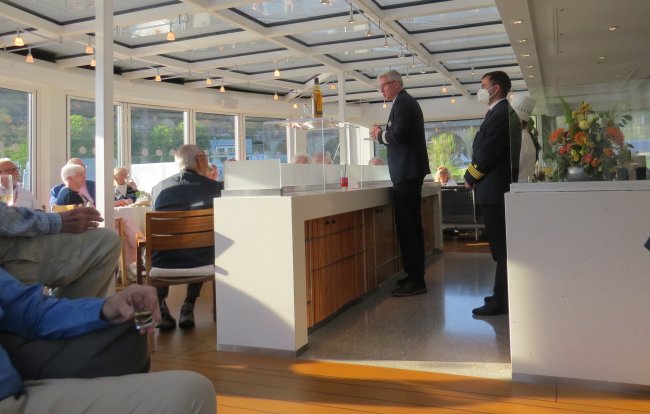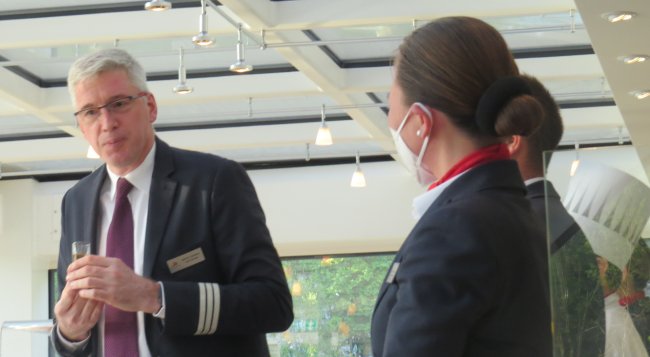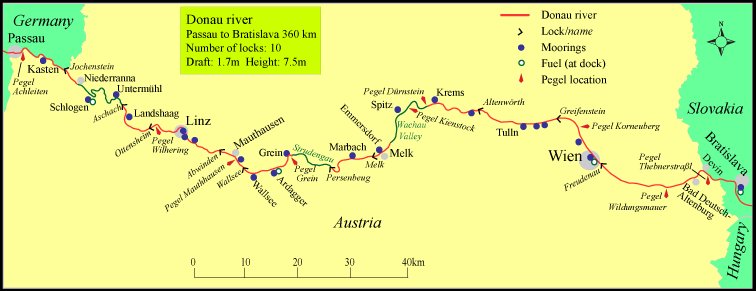I had actually looked up the forecast on Weather.com on all four of the previous mornings. It had not occurred to me to take a screenshot and save it in my notes document until Tuesday. This weather has been extremely good. Based on research that I had done prior to leaving the U.S., I expected to face chilly days with occasional rain.
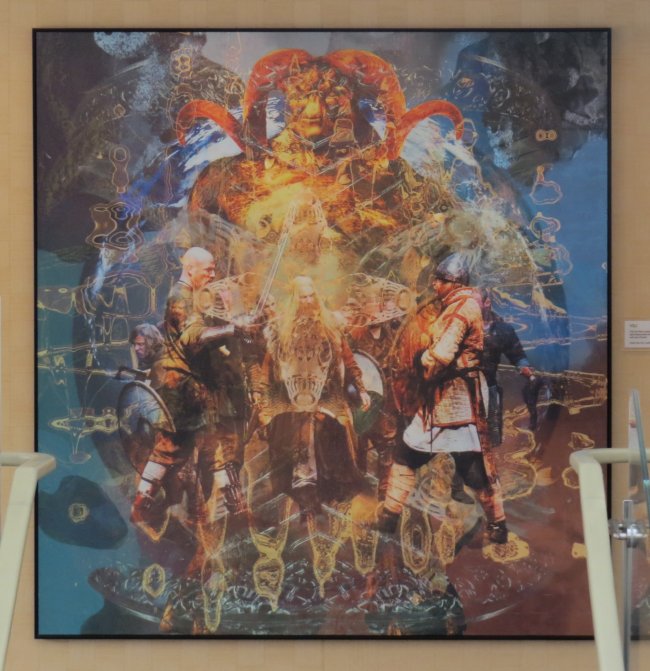
Before the excursion to Melk Abbey: I got up at 4 a.m and worked on the journal for a while. I fell asleep at 6 a.m. and did not drag myself out of bed until after eight. I delivered my saliva sample a little late, and then went to the restaurant for breakfast, which I ate alone.
I overheard at breakfast that someone had tested positive for Covid-29 and was confined to their cabin until they could be dropped off somewhere at a hotel. Evidently the couple involved planned to ask for a refund.
When I returned to room #100 after breakfast I found, along with the Viking Daily and my excursion ticket for Melk Abbey, a shot glass and a pieced of paper that extolled Aquavit. I did not really understand why they gave me these things until I attended the Viking Explorer Society cocktail party.
The schedule for this day was different. There was only one excursion, the visit to the abbey at Melk; it began at 12:45. Lunch, therefore, was moved up to 11 a.m. The other events scheduled for the day were a "cocktail party" at 6:15 p.m. for passengers who had been on previous Viking cruises on the Aquavit Terrace, Gary's daily Port Talk at 6:45, and a "Fun Quiz" in the lounge at 9.

The Viking Daily called the period between 9 and 11 a.m. "Scenic Sailing". We passed a few towns nestled in the hills. Gary was up on the Sun Deck to provide a play-by-play description of what the ship was passing, but I was sort of in the groove in working on my journal, and I also expected to need another nap.
When the groove began to fade I went up to the fourth deck with my camera, recorder, and library book. On the way up I made a cup of coffee using one of the machines outside of the lounge. On the Sun Deck I found a comfortable chair with a good view of the shore on the north side. At 9:50 I turned on my recorder and heard the tail end of Gary's description of the empires of Charlemagne, Napoleon, and Hitler. He then informed us that "one of the most important churches along the Wachau Valley would be coming up." He pronounced it VACK ow, but I am pretty sure that the preferred pronunciation is vah COW.
It suddenly occurred to me that many years earlier I had listened to a short piece on an Acquerella Italiana[1] tape about wine produced in this region as well as in Cinque Terre. I was pretty sure that there was a third region, the name of which I could not remember. The segment was an interview with the president of an organization[2] that promoted European wines that were grown under challenging conditions. The slopes in this region were not as severe as what I remembered from Cinque Terre, and the areas devoted to vineyards also seemed much smaller. However, the vintners in this area seemed to use terracing in much the same way that they did in Liguria.
I recorded about an hour and a half of Gary's narration. Unfortunately, because of the wind and other ambient noise, it was barely intelligible. I had to listen to it with earphones to make sense of it.
Gary told us that the Danube served as a natural boundary for the Roman empire. The Romans used the river for transportation of people and goods, but they only sailed downstream. Ships that reached their destination were removed from the water, disassembled, and used for something else.
Later "chain ships" were reportedly developed. The chains stretched from the ships to the shores. There people would tow the ships by hand upstream. Gary describes this task as "oddious". I had to listen to it several times before I realized that he was saying "arduous".
Someone asked Gary about fishing in the Danube. He said that the local inhabitants did fish in the river. The most common fish was carp, which he said he was not eager to eat because it was a bottom-feeder. He also mentioned that the largest fish in the river was the sturgeon.
Gary said that the Wachau Valley was able to produce wine because it had a "microclimate" that provided it with more sunlight than anywhere else in Austria. I had never heard the phrase microclimate before.
Somehow the subject of apricots and cherries came up. Gary said that the people in this area use them to make Schnapps. In Gary's pronunciation it rhymed with "claps".
He also pointed out some castles to us. They were mostly in ruins. I told my recorder that the one that was high up on the hill was called Castle Augustine. I might have heard wrong
European river cruises were dramatically different from ocean cruises. One of the most striking differences was that on a river cruise there was very little time during the day in which everyone was on the ship but not in the restaurant. This morning was an exception to this rule. The ship was not slated to arrive at the only scheduled port of call, Melk, Austria, until 12:45.
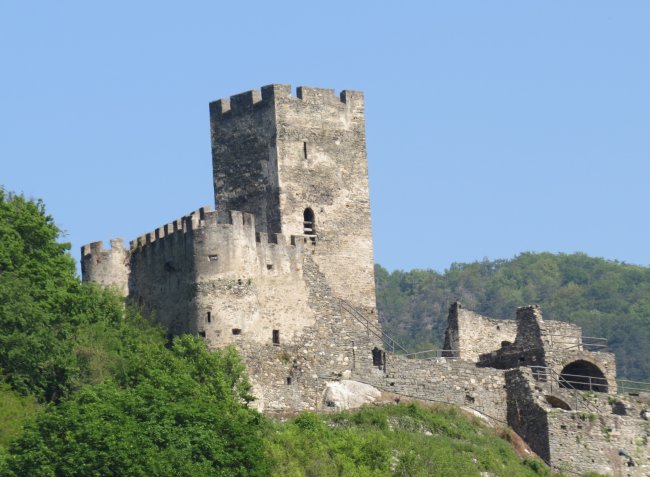
We who were participating in the only excursion offered would be left off at the dock in Melk where buses would take us the short distance to the famous Abbey. After the end of the tour the buses would transport us to Ybbs an der Donau where at 4 p.m. we would board the Viking Vili again.
This was done so that the ship could sail through two locks[3] while the majority of the passengers were ashore touring the abbey. There was not a lot to do on the ship, and when it was moving up or down in a canal the view was predominantly of barren concrete walls in alarmingly close proximity to the vessel. In this case the buses used for the excursion could traverse in less than half an hour the same distance that the ship needed three hours and fifteen minutes to cover.
In almost every respect this was a good approach. However, it made life difficult for those who had made plans based on the published itinerary. This stop provided a good example. If group of passengers had already visited the abbey on a previous occasion, they would not easily be able to explore the nearby town of Melk for any other purpose. In point of fact, we did not even see the town from the bus.
I ate lunch alone. The chicken tikka masala and jasmine rice was quite tasty. I downed two glasses of iced tea. Dessert was peach Melba ice cream. A guy[4] at the next table was continually man-splaining things to the three ladies whom he sat with. His wife never said a word. I noticed that by the end of the tour everyone gave them a wide berth.
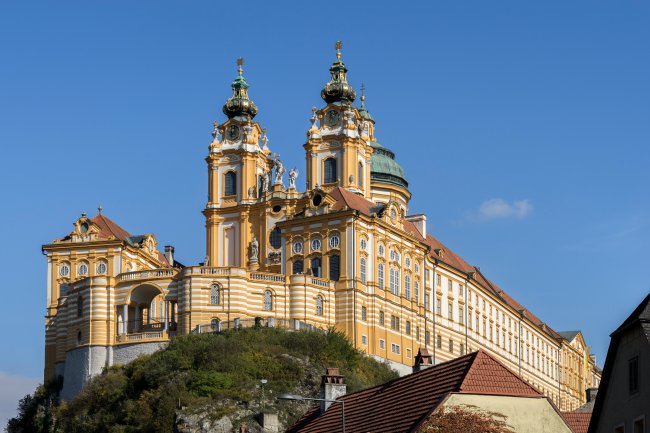
The Melk excursion: At 12:31 p.m. Gary gave us our marching orders:
As I was walking toward the door I put on my mask. The strap pulled out of the mask section. Tried to tie it to the hole, but that made the strap much too short. I wore one of my N95 masks instead. I later picked up another European mask at the reception desk. Thereafter I was careful to keep a spare with mask in a back pocket.
Because this was the only excursion offered on this day, there were enough of us to be divided into three groups. I was in 43B. Our bus was not very crowded. As always, I sat by myself.
We reached the parking lot so rapidly that I took no photos from the bus. From there we descended a fairly large staircase and walked across an area that contained restrooms, a place that sold food, and other things that I cannot remember. There were quite a few tables and chairs as well as some benches. We then had to wait for a few minutes while Gary picked up our tickets for the tour. By then we had been introduced to our tour guide, whose name I did not record. She greeted us with the astounding (at least to me) news that no photos were allowed anywhere indoors.
Our guide told us that the facility was considered a "stift", which means a donation or endowment, rather than an abbey. The original structure was a castle that had been donated in 1089 by Leopold II, Margrave of Austria, to a group of Benedictines who resided in another abbey. In 2022 only a few dozen monks were associated with the place. She did not say how many actually lived there, but the primary interest seemed to be the school, which had 909 students. Only two monks actually taught at the school in 2022. She did not elaborate on what the other monks did. The salaries of the teachers were paid by the government, even though it was still considered a Benedictine school.
Since the guide used the QuietVoxes, I was not able to record her presentation, and I don't remember much of what she said. I mostly remember that we spent a lot of time in corridors where she pointed to rooms in which various famous celebrated people had stayed. There was also a series of high-tech rooms that attempted to explain the monastic principles set down by St. Benedict.
We were only allowed to visit one room of the famous library. Although the library that served as the focal point of Umberto Eco's famous novel, Il Nome della Rosa burned to the ground in 1297, most of the most valuable manuscripts were saved by the monks. To tell the truth, this room seemed fake to me. The tomes all seemed to be the same size and seemed to use the same binding techniques. In fact they all looked identical. Isn't that suspicious?
The abbey's website claims that two rooms are open to the public, but I remember seeing only one. It hardly mattered. They did not allow us to get close enough to the books to examine them, and no photography was allowed.
The tour ended with a visit to the incredibly ornate baroque chapel. I was not too impressed; I have seen many very ornate churches, and once again, no photography was allowed.
The only thing that made this visit slightly interesting to me was that I noticed that high up in the chapel were bas-reliefs of six popes, three on each side. I could just barely make out the inscriptions. It did not seem to me like a distinguished collection: Agatho (678-681), Leo II (682-683), Stephen IV (768-772), Leo IX (1049-1054), Boniface II (530-532), Callixtus II (1119-1124). The last one might have been Celestine II (1143-1144). The names were in Latin, and I could not be certain that I identified them correctly. I would have paid good money to have been able to use my camera with its 50x zoom.
By the time that I discovered this, the guide was gone. Later I spotted Gary and asked him if he had any idea why those six popes had been honored in the chapel. He replied that he did not know, but he would find out. I never heard back from him.
Although I had spent years reading about the popes, the only name that stood out to me was Leo IX. He was a noble from Alsace named Bruno. He really made a hash of things while he was the pontiff. In fact, I consider him perhaps the worst pope ever, which is really saying something. Not only did he provoke the Great Schism of 1054, which permanently split the Church in two, he also picked a disastrous war with the Normans in Italy. He was even taken prisoner and held captive for nine months until he conceded defeat. He was a protégé of Hildebrand (a Benedictine monk) and considered a "reformer".
On the walk back to the bus I took a few photos. I arrived at the bus dedicated to group 43B quite a few minutes before 3:30, which was the time that Gary had specified.
After the excursion: We were back on the ship by 4:00. I spent the next few hours researching the popes whose names I had recorded at the abbey. Here is what I found:
- Agatho and Leo II both ruled during the "Byzantine Papacy", in which the Byzantine Emperor or the Exarch in Ravenna were allowed to confirm the election of the pope. Both were from Sicily!
- Boniface II was the first Germanic pope.
- Stephen IV was only pope for seven months. His major accomplishment was crowning Louis the Pious as the Holy Roman Emperor. The second pope named Stephen only lasted three days. Therefore, depending on when the image was produced, Stephen IV may refer to the pope who ruled from 768 to 772 and who is now called Stephen III. Since he was a Benedictine monk, I would judge this likely.
- Callixtus II was Guy of Burgundy, a very lofty noble. He became Bishop of Vienne when he was in his early twenties. His papacy was in the post-Crusade period that was dominated by Benedictine monks. He was elected pope at the Benedictine abbey in Cluny. He is best known for engineering something of a solution to the investiture controversy in the Concordat at Worms.
- Celestine II, an Italian, died less than six months after his election. His primary accomplishment was removing the interdict his predecessor had imposed on France.
In short, most of them were obscure, and they did not seem to have any clear connection to Melk or to one another.
At 6:15 I went up to the Aquavit Lounge to attend the "Cocktail Party" for the "Viking Explorer Society", which is what Viking calls repeat passengers. Martijn made a presentation about the Scandinavian drink, Aquavit. I did not bring my recorder, and I do not remember what he said.
I skipped the port talk. I was committed to going to Salzburg, and most of that tour would be guided.
I ate supper by myself. I did not write down or record what I had, and I don't remember.
At 9 p.m. a "Fun Quiz" was scheduled for the lounge. I thought about going, but Gary was in charge, and I suspected that his idea of fun might not match mine. Also, my brainpower at that hour was not very good. I probably should have gone. If Sue had been with me, we definitely would have gone; we were very good at each remembering half of an answer. Instead I read some of my library book and then went to sleep shortly after nine.
Evaluation: This day was nothing but disappointments. The Wachau Valley was pleasant and relaxing, but it was in no way as stunning as some had described. I was quite disappointed that the Göttweig tour had disappeared from the itinerary. Surely, those of us who had signed up for it should have been notified.
Stift Melk was a huge disappointment to me. We were shown very little of the monastery and only a small percentage of the library. I find it outrageous that no photography was allowed inside. At the very least Viking should have warned us about this. Rick Steves' guidebook did not mention this tidbit either, and he gave it his highest rating. I don't understand why so many people pay to visit it. I have felt let down when visiting sites before,[5] but this disappointment ranks with the worst.After supper it occurred to me that on our trip scheduled for 2020 Sue and I had actually planned to spend the last of our three extra days in Vienna taking a bus trip to Melk to see the abbey. We planned to tour the abbey on our own and then take the bus all the way back to Vienna. If we had actually done that, we would have ended that vacation on a very sour note. I still felt disappointment, but at least I had not wasted a whole day on it, and there was still plenty of time left to salvage the vacation.
[1] In total there were ten locks on the Danube in Austria. On the above map they are denoted with a ">". Gary later said that the total number of locks was sixty-seven, mostly on the Danube-Main canal and the Main river, which is "channelized".
[2] The story appeared in Anno XIII, No. 1, which was copyrighted in 2007. The stories were printed in Italian on the even numbered pages opposite notes explaining difficult aspects of the text. A cassette tape was included. On it the stories were read by various Italian journalists and actors. It was designed for people like myself who were trying to learn Italian. The publishing company, Champs-Elysees, Inc. of Nashville, TN, went out of business in 2010, allegedly because of legal problems.
[3] I found the magazine that contained the story in the bookcase in my office. The organization was called CERVIM, which stands for Center for Research, Environmental Sustainability and Advancement of Mountain Viticulture. The interview was with its president, François Stevenin. A different interview (also in Italian) with Stevenin is available here. The organization still exists. Its website is here. They promote the wines not because of any particular taste but because they are "heroic" due to the fact that it is so difficult to grow the grapes on steep slopes or in lofty altitudes or harsh climates.
[4] For some reason this foursome always seemed to be assigned to the same excursion group as I was. He was always trying to be the "assistant tour guide", and I let it irritate me more than it should have.


